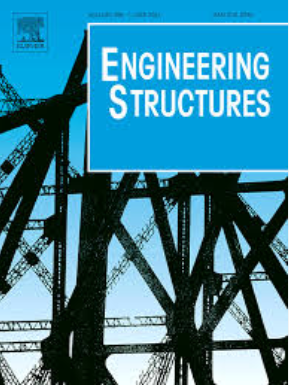钢- uhpc复合材料焊接螺柱与可拆卸螺栓连接件动力响应特性对比分析
IF 6.4
1区 工程技术
Q1 ENGINEERING, CIVIL
引用次数: 0
摘要
本研究通过对钢- uhpc复合材料在冲击荷载作用下剪切连接件性能的冲击试验,探讨了钢- uhpc复合材料的动力响应特性。通过落锤冲击试验,研究了焊接螺柱和可拆卸螺栓连接件的动态响应和破坏机制。实验在不同的试样组上进行,每个试样组根据接头类型进行区分,并受到不同的质量和冲击高度,以模拟不同的冲击场景。试验结果表明,在冲击载荷作用下,除使用高强度螺柱的试件(焊缝破坏)外,所有试件的破坏均为连接件的剪切破坏。这与静态推出测试中观察到的失败是一致的。与焊接螺柱相比,可拆卸螺栓具有更高的极限滑移和更好的延展性。量化了螺柱与超高性能混凝土在冲击载荷作用下的能量分布和转化关系,以及它们的破坏模式之间的映射关系。值得注意的是,研究表明,在UHPC中嵌入螺母的可拆卸螺栓连接器可以通过限制局部损伤程度并保持钢与UHPC界面的完整性来提供优越的性能。研究结果为复合材料元件的动态设计和优化提供了有价值的见解,为增强结构抗动载荷的弹性提供了指导,并有助于更安全的工程应用。本文章由计算机程序翻译,如有差异,请以英文原文为准。
Comparative analysis of dynamic response behavior between welded stud and demountable bolt connectors in steel-UHPC composites
This study explores the dynamic response behavior of steel-UHPC composite through an impact test focusing on the behavior of shear connectors under impact loads. Using drop hammer impact tests, the study evaluates the dynamic responses and failure mechanisms of welded studs and demountable bolted connectors. The experiments are conducted on various specimen groups, each differentiated by connector type and subjected to different mass and height of impact to simulate varied impact scenarios. Test results indicate that under impact loading, the failure for all specimens, except those using high-strength studs (which experienced weld failure), is shear failure of the connectors. This is consistent with the failure observed in static push-out tests. Compared to welded studs, demountable bolts exhibit higher ultimate slip and better ductility. The study quantified the energy distribution and transformation relationship between stud and UHPC, and the mapping relationship between their failure modes under impact loads. Notably, the study shows that demountable bolted connectors with nut embedded in UHPC can provide superior performance by limiting the extent of local damage and preserving the integrity of the interface between steel and UHPC. The results contribute valuable insights into the dynamic design and optimization of composite elements, offering guidelines for enhancing structural resilience against dynamic loads, and contributing to safer engineering applications.
求助全文
通过发布文献求助,成功后即可免费获取论文全文。
去求助
来源期刊

Engineering Structures
工程技术-工程:土木
CiteScore
10.20
自引率
14.50%
发文量
1385
审稿时长
67 days
期刊介绍:
Engineering Structures provides a forum for a broad blend of scientific and technical papers to reflect the evolving needs of the structural engineering and structural mechanics communities. Particularly welcome are contributions dealing with applications of structural engineering and mechanics principles in all areas of technology. The journal aspires to a broad and integrated coverage of the effects of dynamic loadings and of the modelling techniques whereby the structural response to these loadings may be computed.
The scope of Engineering Structures encompasses, but is not restricted to, the following areas: infrastructure engineering; earthquake engineering; structure-fluid-soil interaction; wind engineering; fire engineering; blast engineering; structural reliability/stability; life assessment/integrity; structural health monitoring; multi-hazard engineering; structural dynamics; optimization; expert systems; experimental modelling; performance-based design; multiscale analysis; value engineering.
Topics of interest include: tall buildings; innovative structures; environmentally responsive structures; bridges; stadiums; commercial and public buildings; transmission towers; television and telecommunication masts; foldable structures; cooling towers; plates and shells; suspension structures; protective structures; smart structures; nuclear reactors; dams; pressure vessels; pipelines; tunnels.
Engineering Structures also publishes review articles, short communications and discussions, book reviews, and a diary on international events related to any aspect of structural engineering.
 求助内容:
求助内容: 应助结果提醒方式:
应助结果提醒方式:


